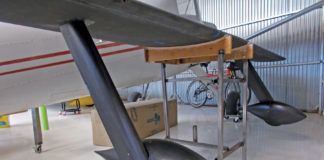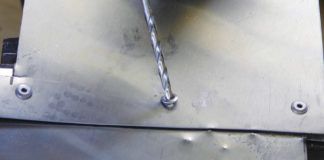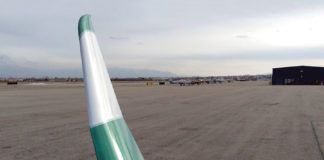Vacuum bagging…it sounds like the next stage of self-expression after you’ve gotten a couple of tattoos and been to the body-piercing shop. But, no, its a process for creating very low weight, complex shapes using composite materials.
In previous articles we looked at wet layups where one soaks the fabric in epoxy and then drapes it over the mold. Youll recall that much effort was expended in getting air out from between the layers and reducing the percentage of epoxy in the product. Youll also remember in our first article in this series that the strength of this technology comes primarily from the fibers; the epoxys job is to prevent shifting of the fibers relative to one another. It follows, then, that when it comes to the epoxy/fiber ratio, the adage, “If enough epoxy is OK, more is better, and too much is just right” is wrong. Once the job of nailing the fibers together is done, more epoxy just adds weight.
Is it easy to have too much epoxy? A beginner at wet layup might have an epoxy/fiber ratio of 90/10. Someone skilled in wet layup will reduce it to less than 70/30. In a sophisticated aerospace component this will drop to 40/60. However, achieving this requires excellent process control, without which you might find uneven distribution of the epoxy to the point of having dry spots. A reasonable target for us is in the neighborhood of 60/40, and vacuum bagging is a great way to get there.
But how important is it to keep the pounds off? If you’re building a Light Sport Aircraft you’re limited to 1320 pounds maximum gross weight. If you’re building an ultralight, well, the name says it all. Keep it under 254 pounds.
Rule compliance aside, there is still the issue of performance. Kelly Johnson of the Lockheed Skunk Works quantified it best: “Each pound adding to the airplanes overall weight cost us one foot of altitude, so in building the U-2 we were ruthless weight-watchers.”
Even if you’re not building the U-3, if you’ve ever taken off with full tanks, all the seats full and the baggage area maxed out, you have a feel for the advantage of permanently removing 50 pounds from the airplane. (Thats why Im on a diet.)
Getting there consistently, though, requires a bit more than a pin to get the air out and a squeegee to remove the excess resin. (That refers to the epoxy, not the diet.)
Thats where vacuum bagging comes in. It uses air pressure to squeeze out the excess epoxy and trapped air. This improves the bonding between the layers, decreases the cure time, and will frequently get you down to that target of 60/40.
You’re thinking, “Oh, sure, but I cant do that in my little shop.” Ah, but you can, Grasshopper, and its neither difficult nor expensive. If you’ve already done a wet layup you’ll need just a few more items, the most expensive being a vacuum pump. However, even that can be had without too much pain. In fact, in a future article, well show you how to build a nice vacuum pump that is powered by compressed air.
Youll notice that I did not say, “Use a vacuum pump to suck the air out of the bag.” This is so often stated that the engineer in me goes nearly apoplectic every time I hear it. Hold this thought: Air does not suck, it blows.
A moments cogitation to consider the tensile strength of air should convince you that the vacuum cleaner you use on the carpet is really a pressure-differential cleaner. The “vacuum” in vacuum pump, as opposed to a compressor, is simply a sloppy way to describe whether the machine alters air pressure to above or below ambient. Its important to understand this concept, because without it you’ll not understand the why if something goes wrong in this process.
The Setup
The basic idea is simple: In doing a wet layup, we used peel ply and a brush to soak out the excess epoxy. This time, well mechanically squeeze it out.
You could try to sit on the bag, but as you do so you’ll remember the last time you tried to squeeze the air out of an air mattress. Tough to flatten out those random pockets of air wasn’t it? Sort of like playing Whack-a-Mole at the amusement park. Instead, lets get Mother Nature to sit on the bag. All we have to do is push a bit of the air out of the bag with a vacuum pump, and the rest will take care of itself.
One more digression into science. Air pressure is simply the load exerted by the weight of the air above a specified area. Go up, and the air pressure decreases because you’re now above some of it. At sea level its 14.7 psi; at 18,000 feet above sea level its half that. If you don’t think air has a weight, put a flattened basketball on a gram scale, then pump it up and weigh it again.
What that means is that unless you live in a very deep hole in the ground such that the air pressure is greater than at sea level, the absolute limit you’re going to place on the bag is 14.7 psi. Now, 14.7 psi is not a trivial load; on a part measuring 12 x 12 inches, youd have to stack 42 50-pound bags of sand in perfect distribution to get the same effect. The reason you don’t feel that weight is because you’re 99% water, which simply transmits the load through you without crushing you.
Taking a look at the diagram, we see that there are a lot of components to the bag. The vacuum bag, fabric, peel ply, wax and mold are all familiar by now, and a vacuum pump is obvious. But how do the sealant tape, perforated plastic and breather material fit in? Clearly, to transform the bag material into a bag you have to seal it. Thats the job of the sealant tape. Its a putty-like material that adheres to the bag material. It comes as a roll and is roughly one-eighth by one-half inch when laid out. You strip off the paper that protects its sticky surface and simply push the bag material into it. Wrinkles should be avoided as much as possible because they are leak paths.
Vacuum tubing is vital. Obviously, Tygon tubing will simply collapse, so a more rigid material is required. Size is not critical; just keep it short, 4 to 5 feet maximum, and unkinked.
Last is the pressure differential generator, aka vacuum pump. This can be anything from a vacuum generator (no moving parts) that hooks up to your compressor, to an aquarium air pump, to a big-bucks industrial vane or screw-type vacuum pump. The size of the pump is entirely dependent upon the size of the project and the integrity of the bag. You should be able to achieve a solid squeeze in 5 to 8 minutes. Too small a pump and you wont keep up with the inevitable leaks.
To explain the function of the other parts, lets go into the bag to see what happens when the pressure is on. First, the bag itself starts to collapse, pushing against the bleeder cloth. Remember that air mattress? Tough to get out those random pockets of air. Thats where the bleeder cloth comes in. Its a thick, porous mat that gives the air a path by which to escape the outside push.
The bleeder cloth has another use. The gases and excess epoxy pass into it with the liquids being trapped, and the gasses continue through the breather material and out through the vacuum pump. Its somewhat akin to wearing socks on a wet carpet. The water gets squeezed out of the carpet and into your socks through a combination of capillary action and a pressure differential.
Speaking of pressure, the bleeder cloth also serves to distribute it evenly. Without it, any wrinkles in the bag would define the surface contour of the finished part just like a wrinkle in your pillow leaves you looking like you’ve fought a saber dual. As the bleeder cloth collapses, it pushes against the perforated release film and the peel ply. Epoxy, being a liquid, is non-compressible, so it squeezes through the weave in the peel ply, through the small holes in the release film, and soaks into the bleeder cloth.
The air bubbles in the epoxy also are forced through the release film and, as the layers descend, they push the fabric against the mold. The epoxy/air between the fabric and the mold gets pushed through the fabric, through the holes in the release film, and it also deposits into the bleeder cloth. Just like that, you’re at the 60/40 ratio.
I should note here that some of my sources tell me that peel ply is optional, but that its good for fine-tuning the ratio of the epoxy to fiber. Its also a good filter to keep strands of the breather material away from the epoxy-fabric, but it means the part will assume the texture of the peel ply.
Choices and Tradeoffs
Is this the only way to vacuum bag a part? Of course not! Thats the fun of this process. Its open to invention and variation once you understand the basics. For instance, to make a flat layup such as an extra thick spacer, you could use painters plastic for the bag, kitchen sponges to soak up the excess epoxy, Dacron material from the fabric store (thats what peel ply is made from), duct tape to seal the bag, windshield washer hose for the vacuum line, an aquarium air pump for a vacuum source and skip the perforated release film if its a part smaller than about 10 square inches. I did it, and it worked great.
Another variation was demonstrated by AirCrafters Guru of Glass, Harold Bunyi. Hes a bit more elegant in making up the windows for a Lancair when he bonds two existing shells into a single component. The bag goes completely around the assembly and, when the pump is turned on, it gets about 4000 pounds of perfectly distributed pressure while the adhesives do their thing. And that vacuum pump that uses compressed air? Heres a hint: Bernoulli. Well show you how to build one next month.
For more information about AirCrafters builder assistance, call 831/722-9141, or visit www.aircraftersllc.com. A direct link can be found at www.kitplanes.com.




